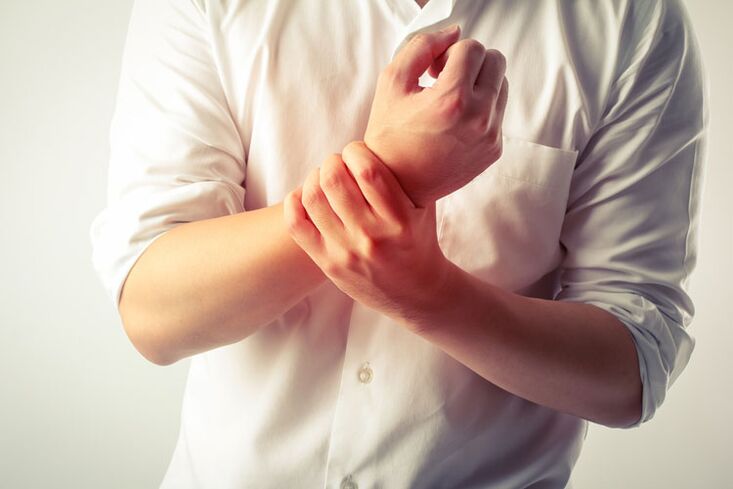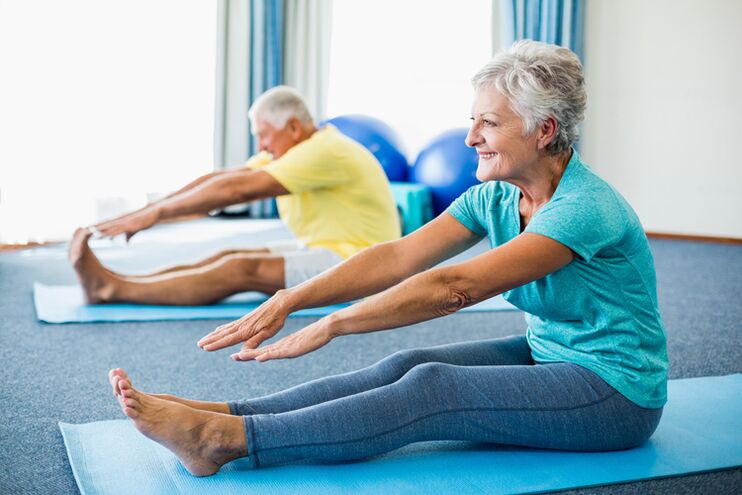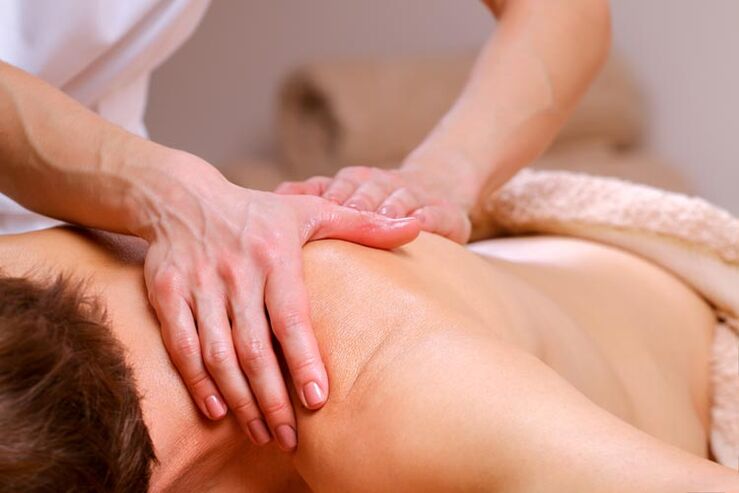
Osteochondrosis is a disease that is one of the most common in the world.Most people after 35 years of age have cervical spinal osteochondrosis in one form or another.Recently, there is a tendency to increase the number of people suffering from severe illnesses and rejuvenates the disease, lowering the lower age threshold.This is due to the fact that the increase in the number of people around the world is involved in inactive work and in an inactive lifestyle.Meanwhile, the disease is quite dangerous, and where people should know what it is - osteochondrosis, how it shows itself and how it is treated, can recognize symptoms and start treatment in a timely manner.
The cause of cervical osteochondrosis
Osteochondrosis is one of the few diseases that has only human characteristics.The disease does not occur in other animals.The reason for this is a special feature of humans as a vertical walk.The vertical position of the spinal column leads to the fact that the vertebrae presses each other and the spinal osteochondral tissue gradually decreases and becomes defective.
The human spine begins from the cervix region.There are a total of seven vertebrae in this section - from the first to the seventh.The vertebrae is separated from each other by the intervertebral disc. The cervical spine is a very exposed, associated part, first of all, with increased vertebral mobility in this area.In the cervical region, the disease is indicated primarily in the disc, which is a weak point in the spinal structure.
The prevalence of cervical osteochondrosis is also facilitated by factors such as small sizes of vertebra and relative weakness of the neck muscle.Also, the development of cervical osteochondrosis is greatly affected by inadequate blood supply to cartilage tissue.
Therefore, the development of the disease is a complex and long process and has no cause.Although the connection has been established between a person's inactive work and the presence of cervical osteochondrosis, however, the disease often occurs in trained people, especially athletes, due to increased load on the cervical spine during weight lifting.
In older people, as a rule, the deterioration of the vertebral structure is an inevitable process related to body aging and its defense weakness.However, the most common types of pathology of cervical osteochondrosis occur, where external or internal negative factors play a major role.
Factors contributing to the development of neck osteochondrosis:
- Weak posture
- Spinal curvature
- Back injury
- Overweight
- Hard physical work
- Work is not active
- A sedentary lifestyle
- Metabolic disorders
- Frequent hypothermia
- Position uncomfortable during sleep
- Pressure, hard work
- Descendant
- Contagious
- Characteristics -Check the individual body structure, for example, the neck that is too long or too short
Stage of development of cervical osteochondrosis
The disease has four stages.It is not necessarily easy to determine the level of the disease by analyzing the symptoms, as sometimes the degree of deterioration of the osteochondral tissue may not be in accordance with the symptoms observed in the patient.

First degree
The damaging process begins in the vertebral osteochondral tissue.As a rule, at the level of cervical osteochondrosis, the symptoms -the symptoms are mild.Patients are either unaware of it or do not associate it with spinal disease, but highlight them to stress and hard work.
Second
The height of the disc begins to decrease, and the cracks appear on the surface.Symptoms of cervical osteochondrosis at this stage show themselves in pain, weakness, and numbness in certain areas.
Third degree
Disc herniation forms, cervical vessels and muscles are damaged.The patient has dizziness and pain in the back of the head.
Fourth degree
Osteophytes appear - the growth of bone tissue protects the vertebra from pressure, leading to the pinching nerves.This leads to the stiffness of movement and damage to the neighboring joints.
Cervical osteochondrosis: symptoms
The main symptoms of cervical spinal osteochondrosis:
- Neck pain and shoulders
- Muscle weakness
- An increase in sweating
- Hands of a numb
- Loss of coordination
- Dizzy
- The deterioration of vision and hearing
- Increased blood pressure
- Headache
These symptoms, typical for cervical spinal osteochondrosis, can be present at all stages of the disease.In most cases, only a few symptoms from the list are observed, and the rest may not be present.Someone who found the signs of the disease for the first time did not always suspect that he had cervical osteochondrosis.Therefore, he can contact various doctors - therapists, cardiologists, neurologists, surgeons.And as a result, the correct diagnosis can be made with significant delays.

Syndrome
With cervical osteochondrosis, some syndrome occurs, which is a common condition with signs of complex features.They show themselves depending on the nerves and arteries affected by the disease:
- Vertebral artery syndrome
- Heart syndrome
- Hypertension syndrome
- Radicular syndrome
- Cervical migraine syndrome
Vertebral artery syndrome is one of the most unpleasant and harmful complications to cervical osteochondrosis.It is caused by a decrease in blood flow through the artery that runs along the spine and supplies the brain.This syndrome shows itself in symptoms such as systemic or periodic dizziness, weak hearing and vision.In some cases, fainting may occur.Variations of the syndrome are often observed, where under normal conditions of blood flow in the artery is normal, but when the head is turned on in one direction or another, it can fall sharply.
Heart syndrome develops when the nerve root of the diaphragm or pectoral muscles is compressed.As a result, the patient may experience pain that reminds the cardialgia, although there is no direct effect on the liver.However, this syndrome can be characterized by phenomena such as tachycardia, hypotension and arrhythmia.
Hypertension syndrome is also one of the most dangerous complications.Unlike vertebral artery syndrome, it is caused by compression of the veins rather than the artery, which prevents blood flow from the head.This syndrome leads to increased intracranial pressure, which can be seen in symptoms such as nausea, vomiting, and headaches.
Cervical migraine syndrome has little similarity to its etiology with classic migraine.It shows itself in severe pain in the back of the head.Pain is paroxysmal, lasting for ten hours and accompanied by vomiting.
Radicular syndrome is the most common syndrome in cervical spinal osteochondrosis.Due to compression of the individual nerve root in the cervical vertebra.It can be expressed in pain in the neck, back of the head, shoulder blades, shoulders, numbness and weakness of certain areas of the arm (until the inability to perform any manipulation) and neck.
Often, some of the individual syndromes or symptoms of different features of the syndrome can be seen at once.
As you can see, with cervical spinal osteochondrosis, the manifestation of the disease is diverse and the patient is not always able to recognize the cause of their occurrence properly.If you face the same symptoms, then this is the reason to consult your doctor.
Diagnostics

To create a diagnosis, it is recommended to consult a therapist.He will refer to experts - orthopedics, vertebrologists, neurologists.
The following types of studies are used for diagnosis:
- Radiography
- Computed tomography
- Magnetic tomography
- The ultrasound scanning of the neck vessel
X -Ray allows you to determine vertebral displacement, presence of growth - osteophytes and salt deposits, and disk compaction.The computed tomography involves creating a series of x-rays that provide three-dimensional organ views, in this case the cervical spine.It allows you to detail the level of pathological processes - nerve compression properties, osteophytes structure, disc height, and other.Magnetic resonance imaging, based on the physical effects of nuclear magnetic resonance, gives a more detailed picture of the spine.Ultrasound of the neck vessel helps to identify changes in blood flow in the neck vessels caused by the disease.
Home osteochondrosis treatment at home
How to treat cervical spinal osteochondrosis at home and can it be treated at all?To combat the disease, the drug has developed many methods.Some treatments can be used at home.But this process is long and complete recovery is not possible, especially in old age.However, it is possible to slow down and stop the damage to the spine wherever the disease.
In the early stages of the disease, the method is usually conservative.Several methods used to treat cervical osteochondrosis:
- Medication
- Therapeutic training
- Physiotherapy
- Massage
- A special way to set the spine
If the disease has developed to the last stage, and the destruction of serious osteochondral structures in the spine occurs, surgical intervention can be used to treat cervical spinal osteochondrosis.
Drug
The following types of drugs are used:
- Chondroprotectors
- Vitamin
- Analgesic
- Anti-inflammatory
- Antispasmodics
In the case of acute pain syndrome associated with osteochondrosis, the first priority is its elimination.As a rule, oral drugs are used, but if they are ineffective, anesthetic restrictions are used in severe cases.
For muscle cramps, antispasmodic is used.Muscle relaxants show the biggest effectiveness in osteochondrosis.Ointment containing non-steroid drugs can be used as anti-inflammatory and painkillers.
With the presence of circulation -related syndrome and blood supply to the brain - hypertension and vertebral arterial syndrome, drugs are taken that relieves unwanted effects of this syndrome - a decrease in blood pressure and nootropic drugs.
Therapeutic training
Physical therapy is the simplest and easiest type of treatment for cervical osteochondrosis and, at the same time, is quite effective.Physical therapy can also be done at home.With osteochondrosis, exercise intensity does not play a deciding role;Only the order is required.First of all, Physical Education aims to strengthen the neck muscles, which balances inadequate spinal function and helps it support weak vertebrae.

Daily exercises are recommended to strengthen the neck muscles.They can be very simple, consisting of switching and tilting their heads in different directions, or more complex, including help to the neck muscles from the hands.They can be done at home and at work.For example, if work is inactive, then it is useful to do such exercises after an hour of sitting at a table or monitor.However, they can only be done outside the hunting period and without pain.Otherwise, they can only worsen the situation.
Strengthening muscles -Shoulder bounding is no less effective, for example, through frequent exercise with light dumbbells.However, lifting heavy objects (heavy, barbels) are contraindicated.Regular swimming, which relieves pressure on the spine, is also useful.
Physiotherapy
Physiotherapy is a method of treatment that uses certain physical and radiation fields to affect the body.Physiotherapy positive property is that it has a minimal number of contraindications.
The following physiotherapy methods are used to treat osteochondrosis:
- Ultrasonic exposure
- Laser therapy
- The effect of the magnetic field
- Exposure to electrical current (electrophoresis)
Magnetic fields have a positive effect on damaged tissues and have anti-inflammatory and analgesic effects.Ultrasound improves metabolic processes in tissues and relieves swelling.The same can be said about laser therapy.Electrophoresis is most commonly used in conjunction with medicines, as the use of electrical current accelerates their absorption by the body.
Massage

Massage reduces increased muscle tone, which causes cramps, and reduces lymph flow, which causes swelling.This procedure helps improve blood circulation in the affected area, which stops the process of destruction of the intervertebral disc.
Other treatment
What to do with cervical osteochondrosis if the classic home treatment method does not help?To reduce the load on the cervical spine, a special device is used - shants collar, which fixes the neck in a fixed normal position.It is recommended to wear it when aggravating the pain or during prolonged inactive work.
To avoid severity, you should also arrange a bed.The pillow should not cause the neck curvature, and the mattress should be firm and even.In some cases, special sleep help - orthopedic mattresses and pillows - can help.
















